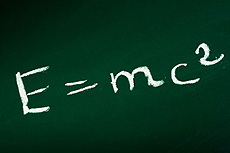E = mc2
 |
Einstein's equation is the most famous one of modern physics; however, it never appeared in his first paper. Instead his paper included the unwieldy but equivalent, K0 - K1 = (L/c2) × (v2/2).
|
Einstein's equation is the most famous equation in history. Even people who have absolutely no interest in science recognize it. But what does it mean?
Well, like all equations, it has a left side and a right side, separated by an equal sign. On the left-hand side is "E," which means energy. On the right-hand side is "m," which means mass, and "c," which means the speed of light. The speed of light is simply a mathematical constant that converts units of energy to units of mass, similar to the conversion factor you'd use to translate feet to inches. In the middle is the equal sign, which just says that the right hand and left hand side are the same. Stated simply, this equation says that energy and mass are the same once you apply the c2 conversion factor to get the numbers right.
That last sentence is such an unassuming one, yet it has huge implications. If two things are the same, you can convert one into another. Scientists who use accelerators like those at Fermilab, CERN and other similar laboratories make this conversion all the time. We accelerate particles to high energies and slam them together. The particles' kinetic (motion) energy can convert into mass energy. This is how particles like the top quark and the Higgs boson are made.
It's important to note that the "m" stands for "mass," not matter. When we convert energy into mass, we do in fact convert the energy into matter, but we also simultaneously convert it into antimatter. Of course, the equal sign in the equation means the conversion can go both ways: You can combine matter and antimatter to make energy. This is the basis for the Dan Brown book Angels and Demons, in which a scientist isolated a quarter gram of antimatter. If that were technologically possible, Brown's story would be feasible. Combining a quarter gram of antimatter and matter would result in an energy release similar to those from the first atomic bombs. Luckily for mankind's safety, it is difficult to isolate antimatter. Fermilab's antiproton source was the world's most powerful facility for making antimatter, and yet 25 years of effort isolated only enough antimatter to warm five gallons of water from room temperature to the temperature of a decent cup of coffee.
One aspect of this equation is kind of mind-blowing. Consider ordinary matter of the kind that makes up you and me. We are made of atoms, which are made, in turn, of protons, neutrons and electrons. Electrons are far less massive than protons and neutrons. Protons and neutrons have similar masses, so we can conceptually combine them as a class of particles called nucleons, indicating their location in the nucleus of an atom. Thus most of your mass comes from the various nucleons in your body.
Things get really interesting when we ask where the nucleons' mass comes from. Each nucleon consists of three quarks, so the obvious answer is that each of the quarks carries about a third of the mass of a proton. However, that's not true. The mass of the quarks is only about 1 to 2 percent the mass of the proton. So where does the mass of the proton come from? Energy.
Inside a nucleon, the quarks are zooming around at speeds near that of light. This gives them a lot of kinetic energy. In addition, they are zooming around in a volume the size of a sphere a quadrillionth (10-15) of a meter in radius. To have something moving that fast in a volume that small requires very strong forces to hold them together. This requires a lot of potential (binding) energy. The combined kinetic and potential energy is the real source of a person's mass.
In essence, there is very little mass in the way we intuitively understand it. Everything is energy. Einstein's equation, first invented over a century ago, showed us a central truth of the universe. Matter is energy.
—Don Lincoln
Want a phrase defined? Have a question? E-mail today@fnal.gov.
|